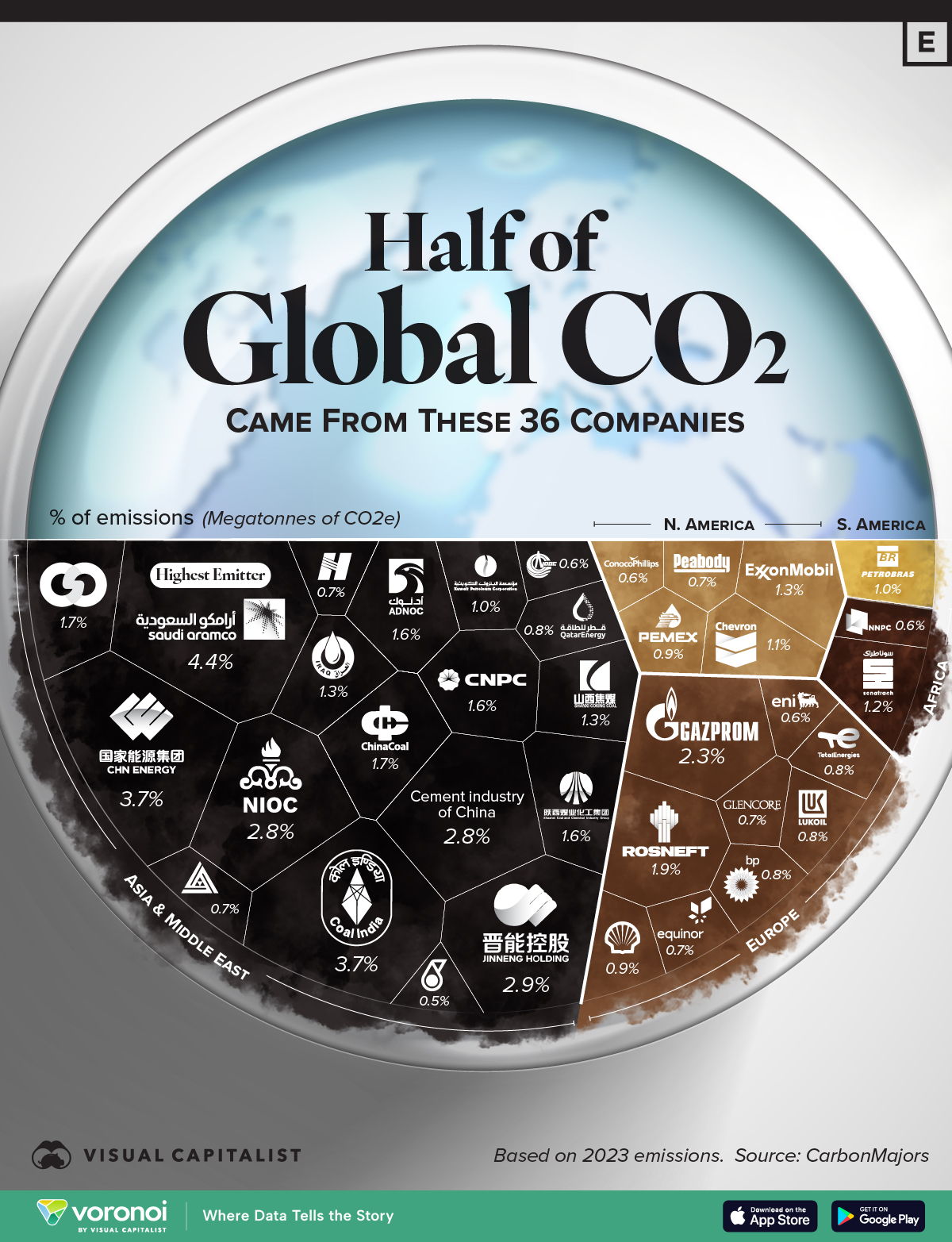Companies with the Most Fossil Fuel and Cement CO2 Emissions
This was originally posted on our Voronoi app. Download the app for free on iOS or Android and discover incredible data-driven charts from a variety of trusted sources.
Key Takeaways
- Half of the world’s fossil fuel and cement carbon dioxide emissions in 2023 came from just 36 entities, according to a report by the Carbon Majors Project.
- If Saudi Aramco were a country, it would be the fourth-largest polluter, after China, the U.S., and India.
- Five publicly traded oil companies—ExxonMobil, Chevron, Shell, TotalEnergies, and BP—together accounted for 5% of global carbon dioxide emissions from fossil fuels.
Chinese Companies Dominate the List
This graphic is based on Carbon Majors, a database of historical production data from 180 of the world’s largest oil, gas, coal, and cement producers representing 169 active and 11 inactive entities.
In 2023, the top 20 highest carbon-producing entities were responsible for 17.5 gigatonnes of carbon dioxide equivalent (GtCO₂e) in emissions, accounting for 40.8% of global fossil fuel and cement CO₂ emissions. The list is largely dominated by state-owned companies, with 16 of the top 20 being state-controlled. Notably, eight Chinese entities contributed to 17.3% of global fossil fuel and cement CO₂ emissions in 2023.
| Entity | Total emissions (MtCO2e) | Global CO2 emissions (%) |
|---|---|---|
| 1 | Saudi Aramco | 4.4% |
| 2 | Coal India | 3.7% |
| 3 | CHN Energy | 3.7% |
| 4 | Jinneng Group | 2.9% |
| 5 | Cement industry of China | 2.8% |
| 6 | National Iranian Oil Company | 2.8% |
| 7 | Gazprom | 2.3% |
| 8 | Rosneft | 1.9% |
| 9 | Shandong Energy | 1.7% |
| 10 | China National Coal Group | 1.7% |
| 11 | Abu Dhabi National Oil Company | 1.6% |
| 12 | CNPC | 1.6% |
| 13 | Shaanxi Coal and Chemical Industry Group | 1.6% |
| 14 | Iraq National Oil Company | 1.3% |
| 15 | Shanxi Coking Coal Group | 1.3% |
| 16 | ExxonMobil | 1.3% |
| 17 | Sonatrach | 1.2% |
| 18 | Chevron | 1.1% |
| 19 | Kuwait Petroleum Corp. | 1.0% |
| 20 | Petrobras | 1.0% |
| 21 | Shell | 0.9% |
| 22 | Pemex | 0.9% |
| 23 | TotalEnergies | 0.8% |
| 24 | QatarEnergy | 0.8% |
| 25 | Lukoil | 0.8% |
| 26 | BP | 0.8% |
| 27 | Glencore | 0.7% |
| 28 | China Huaneng Group | 0.7% |
| 29 | Luan Chemical Group | 0.7% |
| 30 | Equinor | 0.7% |
| 31 | Peabody Energy | 0.7% |
| 32 | Nigerian National Petroleum Corp. | 0.6% |
| 33 | CNOOC | 0.6% |
| 34 | ConocoPhillips | 0.6% |
| 35 | Eni | 0.6% |
| 36 | Petronas | 0.5% |
Coal continued to be the largest source of emissions in 2023, representing 41.1% of emissions in the database and continuing a steady upward trend since 2016. Coal emissions grew by 1.9% (258 megatonnes of carbon dioxide equivalent – MtCO₂e) from 2022, while cement saw the largest relative increase at 6.5% (82 MtCO₂e), driven by expanding production.
In contrast, natural gas emissions fell by 3.7% (164 MtCO₂e), and oil emissions remained stable with only a slight increase of 0.3% (73 MtCO₂e).
Learn More on the Voronoi App 
To learn more about this topic, check out this graphic that shows greenhouse gas emissions by sector in 2023, according to data was compiled by the United Nations. The power sector remains the largest emissions contributor.
The post Ranked: Companies with the Most Fossil Fuel and Cement CO2 Emissions appeared first on Visual Capitalist.

